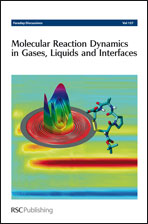Product state and speed distributions in photochemical triple fragmentations
Abstract
The clearest dynamical signature of a roaming reaction is a very cold distribution of energy into the rotational and translational degrees of freedom of the roaming donor fragment (e.g. CO) and an exceptionally hot vibrational distribution in the roaming acceptor fragment (e.g. H2, CH4). These signatures were initially identified in joint experimental/theoretical investigations of roaming in H2CO and CH3CHO and are now used to infer the presence of roaming mechanisms in other photodissociation reactions. In this paper we construct a phase space theory (PST) model of triple fragmentation (3F) and show that the dynamical signature of 3F is similar to that of the roaming donor fragment. The PST model starts with a calculation of two-body fragmentation (2F) of a generic molecule, ABC into AB + C. Every AB fragment with sufficient energy to undergo subsequence spontaneous dissociation is allowed to dissociate and the PST distribution of energy into A + B products is calculated for every initial AB state. Using CH3CHO → HCO + CH3 → H + CO + CH3 as an example, we calculate that the energy disposal into the rotational and translational degrees of freedom of the 3F products is very low, and is similar to the dynamical signature expected for production of CO via a roaming mechanism. We compare the 3F PST model with published
- This article is part of the themed collection: Molecular Reaction Dynamics in Gases, Liquids and Interfaces

 Please wait while we load your content...
Please wait while we load your content...